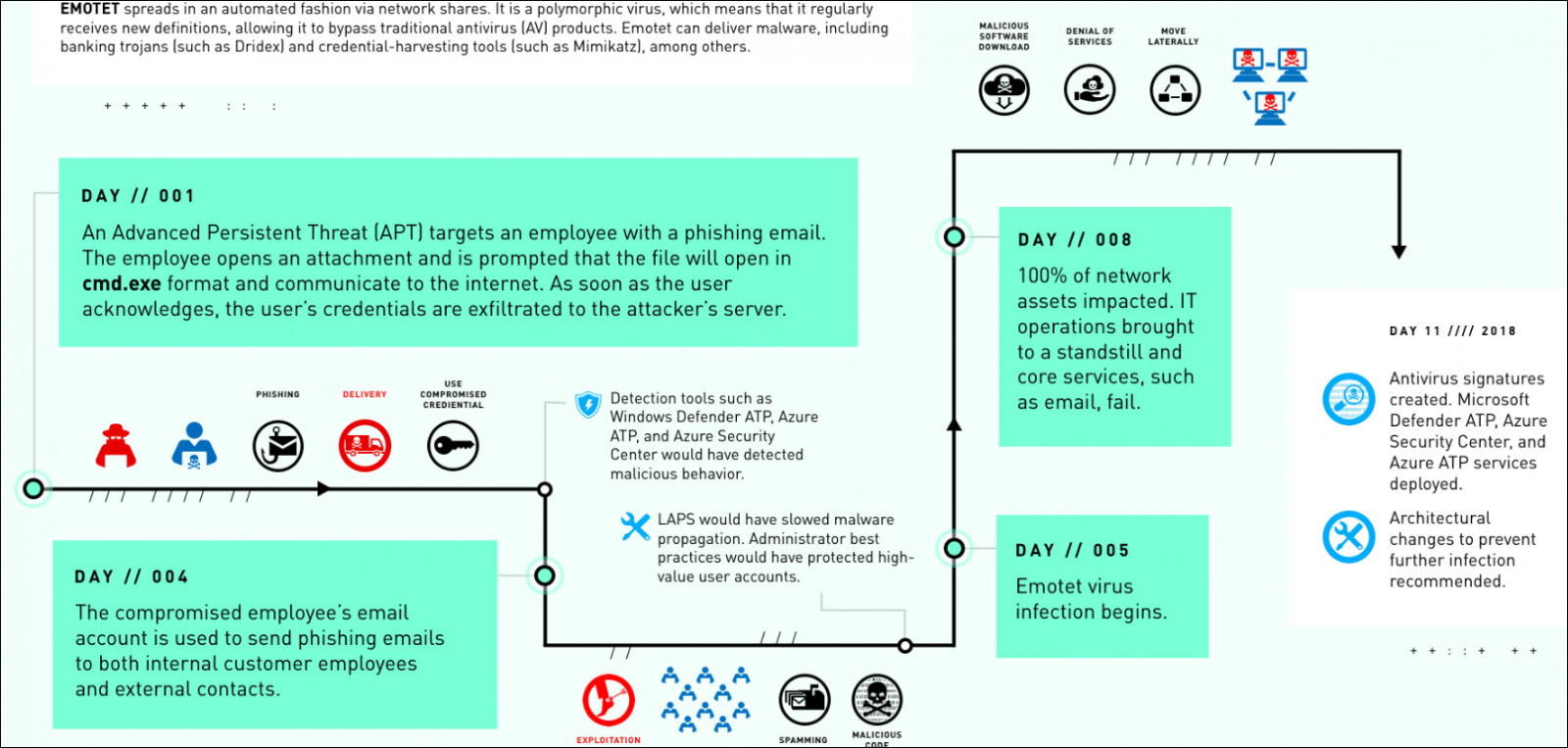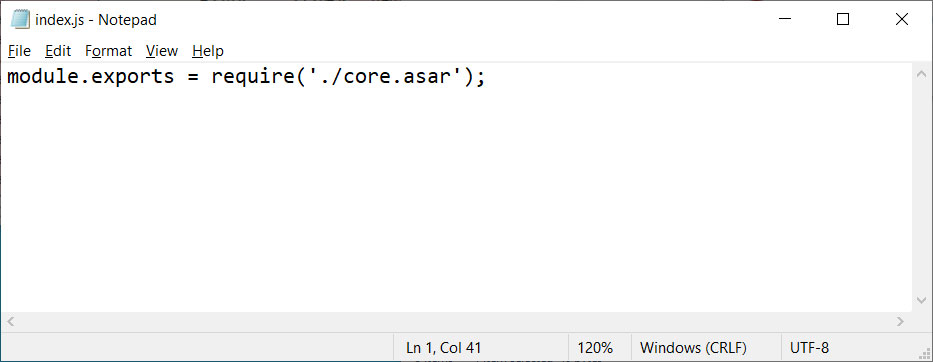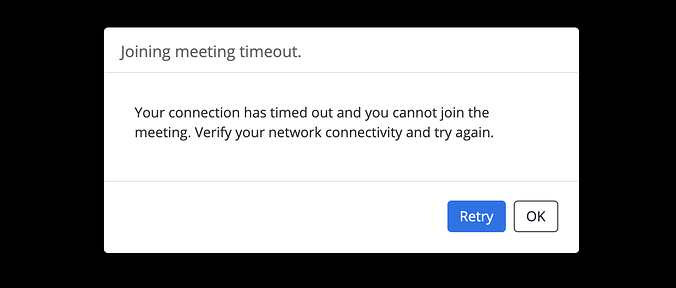By Sergiu Gatlan April 3, 2020 03:25 PM 0

Microsoft says that an Emotet infection was able to take down an organization's entire network by maxing out CPUs on Windows devices and bringing its Internet connection down to a crawl after one employee was tricked to open a phishing email attachment.
"After a phishing email delivered Emotet, a polymorphic virus that propagates via network shares and legacy protocols, the virus shut down the organization’s core services," DART said.
"The virus avoided detection by antivirus solutions through regular updates from an attacker-controlled command-and-control (C2) infrastructure, and spread through the company’s systems, causing network outages and shutting down essential services for nearly a week."
All systems down within a week
The Emotet payload was delivered and executed on the systems of Fabrikam — a fake name Microsoft gave the victim in their case study — five days after the employee's user credentials were exfiltrated to the attacker's command and control (C&C) server.
Before this, the threat actors used the stolen credentials to deliver phishing emails to other Fabrikam employees, as well as to their external contacts, with more and more systems getting infected and downloading additional malware payloads.
The malware further spread through the network without raising any red flags by stealing admin account credentials authenticating itself on new systems, later used as stepping stones to compromise other devices.
Within 8 days since that first booby-trapped attachment was opened, Fabrikam's entire network was brought to its knees despite the IT department's efforts, with PCs overheating, freezing, and rebooting because of blue screens, and Internet connections slowing down to a crawl because of Emotet devouring all the bandwidth.
 Emotet attack flow (Microsoft DART)
Emotet attack flow (Microsoft DART)"When the last of their machines overheated, Fabrikam knew the problem had officially spun out of control. 'We want to stop this hemorrhaging,' an official would later say," DART's case study report reads.
"He’d been told the organization had an extensive system to prevent cyberattacks, but this new virus evaded all their firewalls and antivirus software. Now, as they watched their computers blue-screen one by one, they didn’t have any idea what to do next."
Based on what the official said following the incident, although not officially confirmed, the attack described by Microsoft's Detection and Response Team (DART) matches a malware attack that impacted the city of Allentown, Pennsylvania in February 2018, as ZDNet first noticed.
At the time, Mayor Ed Pawlowski said that the city had to pay nearly $1 million to Microsoft to clean out their systems, with an initial $185,000 emergency-response fee to contain the malware and up to $900,000 in additional recovery costs, as first reported by The Morning Call.
Emotet infection aftermath and containment procedures
"Officials announced that the virus threatened all of Fabrikam’s systems, even its 185-surveillance camera network," DART's report says.
"Its finance department couldn’t complete any external banking transactions, and partner organizations couldn’t access any databases controlled by Fabrikam. It was chaos.
"They couldn’t tell whether an external cyberattack from a hacker caused the shutdown or if they were dealing with an internal virus. It would have helped if they could have even accessed their network accounts.
"Emotet consumed the network’s bandwidth until using it for anything became practically impossible. Even emails couldn’t wriggle through."
Microsoft's DART — a remote team and one that would deal with the attack on site — was called in eight days after the first device on Fabrikam's network was compromised.
DART contained the Emotet infection using asset controls and buffer zones designed to isolate assets with admin privileges.
They eventually were able to completely eradicate the Emotet infection after uploading new antivirus signatures and deploying Microsoft Defender ATP and Azure ATP trials to detect and remove the malware.
Microsoft recommends using email filtering tools to automatically detect and stop phishing emails that spread the Emotet infection, as well as the adoption of multi-factor authentication (MFA) to stop the attackers from taking advantage of stolen credentials.
 Emotet infection chain (CISA)
Emotet infection chain (CISA)Emotet infections can lead to severe outcomes
Emotet, originally spotted as a banking Trojan in 2014, has evolved into a malware loader used by threat actors to install other malware families including but not limited to the Trickbot banking Trojan (a known vector used in the delivery of Ryuk ransomware payloads).
Emotet was recently upgraded with a Wi-Fi worm module designed to help it spread to new victims via nearby insecure wireless networks.
Recently, in January 2020, the Cybersecurity and Infrastructure Security Agency (CISA) warned government and private organizations, as well as home users, of increasing activity around targeted Emotet attacks.
In November 2019, the Australian Signals Directorate’s Australian Cyber Security Centre (ACSC) also warned of the dangers behind Emotet attacks, saying at the time that the malware "provides an attacker with a foothold in a network from which additional attacks can be performed, often leading to further compromise through the deployment of ransomware."
Emotet ranked first in a 'Top 10 most prevalent threats' ranking published by interactive malware analysis platform Any.Run at the end of December 2019, with triple the number of sample uploads submitted for analysis when compared to the next malware in the top, the Agent Tesla info-stealer.
CISA provides general best practices to limit the effect of Emotet attacks and to contain network infections within an Emotet Malware alert published two years ago and updated earlier this year.

 Unmodified index.js file
Unmodified index.js file AnarchyGrabber2 modified index.js file
AnarchyGrabber2 modified index.js file Stealing a Discord user token
Stealing a Discord user token Discord File Check Mockup
Discord File Check Mockup
 Zoom outage map (DownDeetector)
Zoom outage map (DownDeetector) Zoom timeout error (
Zoom timeout error (






 A website dedicated to technology news from Africa… and Ralph Lauren gear?
A website dedicated to technology news from Africa… and Ralph Lauren gear?


























 Enable waiting room setting
Enable waiting room setting Admit a person into the meeting
Admit a person into the meeting



 Manually join a meeting by ID
Manually join a meeting by ID Malicious Zoom installer
Malicious Zoom installer